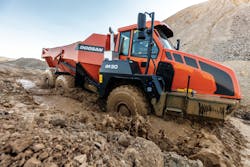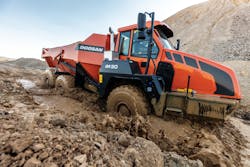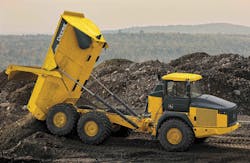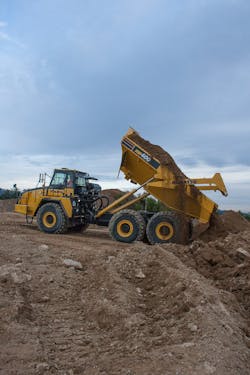Articulated dump trucks are all about moving material from one place to the next over rough terrain and in challenging underfoot conditions. These large, rugged, heavy-duty haulers originated in Sweden in 1955 and were originally used as a soil and aggregate transporter, but their role has since been expanded for use in mining, timber, construction, and highway maintenance applications.
Early versions lacked suspension and automatic transmission, but over the years, this piece of heavy iron has seen changes in brakes, drive train, suspension, and other components that elevate it from its former agricultural tractor origins. Technological innovations continue to improve the performance, efficiency, and safety of the ADT workhorse.
Putting the Brakes On
The biggest benefit of the braking system in most articulated dump trucks is its three-fold system. “First,” explains Aaron Kleingartner, Doosan Infracore North America, LLC, “many articulated dump trucks are designed with a hydraulic transmission retarder to maintain the proper speed when going down a grade when fully loaded.” The system is typically automatic and will shift the truck into the proper gear to maintain a safe operating speed.
The next braking system for use in articulated dump trucks is the engine brake. Kleingartner indicates that the engine brake is “re-routing exhaust through the engine to help reduce the power output of the engine. It helps maintain less torque for the transmission.”
The third braking mechanism is the service brake.
With half of all global sales, Volvo—the primary originator of the ADT—remains the market leader. Rob Palermo, product manager, articulated haulers, Volvo CE, says, “Volvo articulated haulers are the most off-road-capable articulated trucks available,” and adds that they offer several industry-unique features.
Hydro-mechanical steering, high ground clearance, automatic traction control, and 100% differential locks allow the Volvo haulers to work in 4x6 and 6x6 drive combinations. The A45G offers fully hydraulic suspension on all wheels, which permits it to move more quickly and smoothly on rough terrain, in comparison with conventional models, Palermo notes.
But not too quickly on hills. Volvo’s Hill Assist holds a hauler in place on steep slopes without the need to engage the parking brake. Palermo says the feature automatically activates when the machine comes to a complete stop on a hill and is then disengaged when the operator accelerates.
Downhill Speed Control is activated by a three-position switch on the dashboard. “The speed is set to the current machine speed when releasing the accelerator, brake pedal, or retarder pedal when the function is active,” details Palermo. The function, incorporated in the already-existing engine brake switch, is achieved by using a combination of the Volvo Engine Brake and service brakes.
The Dynamic Volvo Engine Brake system features torque and shift points that are dynamically adjusted against the current load, inclination, and rolling resistance. This improves brake life by reducing the need to use the brake and retarder pedal when going downhill. Palermo points out that it also leads to significant increases in max torque.
The Dump Support System enables operators to see the percentage side inclination of the truck and set allowable parameters for safe dumping operations. This feature can be configured three ways: off, on with an alarm, and on with an alarm and a complete bed stop. “The Dump Support System complements Volvo's already user-friendly, patented Load and Dump Brake technology,” states Palermo. The tipping lever has an automatic hold in the lowering position, which provides precise control for faster cycle times.
Advanced Systems and Automated Features
Safety is the top priority on any job site. To protect operators and people outside the machine, John Deere has leveraged sensors to monitor side-to-side slope percentage in the rear chassis. As Cory Ouellette, product marketing manager, ADTs, explains, when a predetermined slope percentage is exceeded, the machine recognizes it and will prevent the dump body from being raised. This slope can be set based on the demands of the job site or operator skill.
Other automated technologies that make the operation of Deere’s ADTs safer, more efficient, and simpler include downhill descent control that automatically matches the gear the truck is into the slope the truck is on. “Controlling a fully loaded ADT down a steep incline is no easy task,” says Ouellette. The truck will apply the transmission retarder as needed to slow the machine, based on the gear and slope, with little to no interaction from the operator.
Komatsu has also incorporated automated systems designed to increase braking and transmission performance in soft and slippery ground conditions without the need for operator input. Komatsu’s Traction Control System monitors wheel speeds and automatically engages and disengages wheel brakes individually, transferring power through the differential to the tire with the most traction without compromising steering performance, which one might experience with a differential lock system, explains Sebastian Witkowski, product marketing manager, Komatsu America.
Komatsu’s articulated trucks are equipped with Komatsu Advanced Transmission with Optimum Modulation Control System, a six-speed, fully automatic transmission that uses an advanced electronic system to eliminate shift shock and torque cutoff, so the engine operates in the most efficient range. Witkowski says the electronic system automatically selects the gear, based on vehicle speed, engine speed, and the shift position selected, resulting in powerful acceleration, smooth down-shifting, and synchronized engine speed when climbing slopes.
Data-driven, fully automated features support operator tasks, maximizing efficiency and productivity. “Typically, operators will cut their teeth in the industry on articulated trucks,” speculates Witkowski, “so features which operate in the background, automatically, help overcome inexperience by reducing potentially harmful operation and providing peace of mind to fleet managers [and] owners by maximizing uptime and protecting investments.”
Telematics and Data Acquisition
Telematics data provides beneficial information that contractors can utilize to calculate accurate life-cycle costs of construction equipment. Previously, some construction equipment owners and fleet managers examined machine specifications to gauge a machine’s fuel economy or base a machine’s utilization rate on what they did on past jobs.
Today’s telematics data gives contractors a true picture of their construction equipment's performance, allowing them to calculate the real cost of ownership. Contractors have access to telematics data, enabling them to make immediate changes to lower operating costs—particularly fuel consumption.
Data points that are most useful in analyzing construction equipment life cycle costs include fuel consumption and diesel exhaust fluid consumption, but total utilization hours play a part as well because running a machine burns through warranty and consumables such as filters and oils, Doosan’s Kleingartner notes.
“When construction equipment has an error and it is communicated to the fleet manager or dealer, this is useful in determining machine life cycle costs,” he continues. Fleet managers can utilize data from all brands of construction equipment to compare one machine with another. An API data feed allows contractors and fleet managers to pull telematics data from their entire fleet into their fleet management software, thereby improving a company’s ability to monitor an entire fleet rather than machine by machine.
Komatsu’s remote equipment monitoring and management system, KOMTRAX, is standard on the 324 net hp HM300-5 to the 466 net hp HM400-5. It continuously monitors and records machine health and operational data. “This monitoring system is designed to allow owners and fleet managers access to machine performance data, including fuel consumption, utilization, and production,” details Witkowski. It provides metrics that can be used to lower owning and operating costs and because it does not require a subscription, it’s considered a no-cost feature.
For in-depth information about operation and production management, Komatsu's Payload Meter system integrates with KOMTRAX. Payload tonnage is displayed on the machine monitor and is visible to the haul truck operator. An external display lamp mounted on the top of the cab communicates payload status to the loader operator, so the payload is always consistent and maximized. PLM data is transmitted by KOMTRAX and can be accessed via internet-enabled devices. Detailed data is stored in the truck’s controller and can be accessed via KOMTRAX or directly downloaded from the truck to a PC.
John Deere Construction & Forestry enables contractors to keep their machines up and running and their projects on schedule through the JDLink monitoring system. This technology allows customers and dealers to be proactive in scheduling maintenance and following up on alerts that may indicate potential unplanned downtime. It also enables the onboard weighing system to send payload data to a designated person to identify operator productivity trends, assess operator performance, and make near-real-time adjustments.
Similarly, Volvo offers a productivity service that shows operators real-time information on their in-cab display. Standard on the A35G, A40G, A45G, A45G FS, and A60H, and optional for the A25G and A30G, Haul Assist provides a set of apps to help operators boost their efficiency.
One Haul Assist app—On-Board Weighing—provides real-time data on loads. “The system is fully automatic, requiring no intervention from the operator,” states Palermo. Three load indicator lights alert the hauler and excavator operators when a nominal load has been reached and can warn the operators of overloading. The hauling operator can also see the actual tonnage displayed in real-time on the Co-Pilot display. This data is also shared and remotely accessible by the fleet manager through CareTrack, Volvo’s standard telematics system, allowing for complete payload management and improved fleet utilization.
Volvo’s machine monitoring and reporting service, ActiveCare Direct, is a “pretty dramatic shift in our industry’s approach to telematics,” says Palermo. Instead of sending the customer every undiagnosed fault code, requiring the customer to analyze raw data and determine what steps to take, Volvo ActiveCare Direct sends them a case alert that includes the probable cause, recommended solution, and potential consequences of not taking action.
This information is also sent to the customer's equipment dealer, so the dealer can follow up with the customer on any potential service needs. Also, it sends owners monthly fleet utilization reports, which provide an overview of a fleet’s performance, efficiency, hours, and instances of machine misuse.
New Models and Features
Volvo added a map feature to its Haul Assist in early 2020 that allows operators to identify their position on a job site as well as the position of other haulers fitted with the technology. Palermo explains that when visibility is restricted, this feature helps operators monitor traffic flow and reduce potentially dangerous situations. “Operators can anticipate the optimum arrival time at load or dump areas, avoiding congestion and wait times, and improving overall site efficiency.”
In 2018, Doosan updated its DA30-5 articulated dump truck with new front suspension, which is now a hydro-gas, self-leveling system with greater shock absorption for better driving comfort, especially when the truck is empty. The truck’s hydro-gas cylinders are connected to pressure accumulators; the accumulators and hydraulic system replace the previous shock absorbers and rubber spring.
Doosan also redesigned the DA30-5 cab interior to provide better ergonomics and more operator comfort. New features include a new dashboard with a modified shape and a soft-touch automotive material, making it easier to clean. Updates to the truck’s vehicle control unit include more robust hardware, better processors, more input channels for customized functions or further technology developments, and high-quality, automotive-style connectors.
Hydrema US introduced a completely new model in 2019: the 707G. Although it’s the smallest truck in their lineup, it has the same features as the 912HM, their #1 seller, says Tom Hartman, business development manager. The G series features Hydrema telematics, unseen on previous models. It’s also their first hydrostatic model, with a bed that rotates 180 degrees, making it a good choice for tight job sites where there’s little room to turn around.
Also good in tight conditions such as mountainous and urban areas, and soft conditions such as golf courses, Hydrema’s 912 and 922, a 22-ton 6X6 truck, both feature 800 mm tires for low ground pressure. Hartman lists typical applications such as environmental work, including stream remediation, where low ground pressure is important. Recently introduced is their 920G, a 20-ton truck with 920 mm tires for even lower ground pressure.
AI
Technology is never at a stand-still, and as Artificial Intelligence becomes more prevalent in the healthcare, computer, and business sectors, it’s not surprising to see it entering the heavy equipment industry. Because of the repetitive nature of the ADT’s work, AI is a candidate for future consideration.
“Automation technology and AI are advancing at a very rapid pace around the world and across many different industries,” observes Ouellette. He says John Deere will continue to focus on delivering advanced ADT solutions but doesn't indicate any definitive plans for AI.
Witkowski says that, while there is a significant amount of potential for complete automation in articulated trucks, this technology will ultimately be driven by market demand and customer needs. When demand calls for it, he says Komatsu has the experience to pull from when it comes to fully automated equipment, from autonomous haulage systems to intelligent machine control dozers and excavators.
Volvo has been researching AI technology since 2017 when it presented an electric, autonomous load carrier prototype and tested several electromobility and automation projects and machines at the world’s first emission-free quarry, Palermo says.
In November 2019, Doosan Infracore demonstrated Concept-X, an autonomous work site, where unmanned construction equipment, including a Doosan articulated dump truck, performed a variety of worksite tasks. This concept has not been commercialized; however, Doosan plans to commercialize its Concept-X technology by 2025 in North America.






